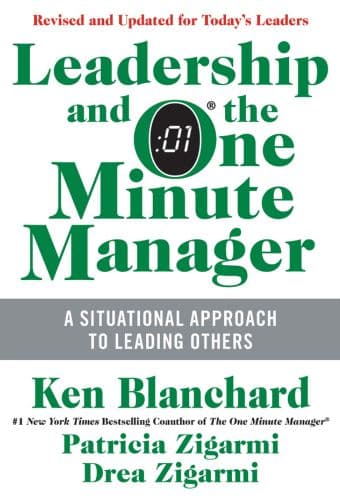
Most managers lead how they like to lead.
Not how their people actually need them to lead.
Leaders need to adapt their leadership style to meet the needs of their team.
It’s simple in theory, but in practice? Much harder.
The workshop below introduces a practical leadership model, drawing insights from the bestselling book Leadership and the One Minute Manager by Ken Blanchard, which helps leaders adjust on the spot.
Whether you’re supporting a brand-new hire or challenging a senior team member to step up.
And why does this matter? Because people don’t leave companies. They leave managers who didn’t lead them the way they needed at the time.
I’ve seen it too many times. A well-meaning leader gives advice when the person needs encouragement.
Or take a step back when the person still needed clear direction.
The mismatch creates frustration on both sides. Results drop. Motivation drops. Sometimes people leave.
The truth is, most managers fail here for a simple reason: they treat everyone the same.
They develop a default leadership style (whether it’s hands-on or hands-off) and apply it to every situation.
It works for some people, but it alienates others.
Over time, that inconsistency erodes trust and performance.
If I could say one thing about leadership today, it’s this:
Your people’s needs change faster than your habits. And if your leadership doesn’t keep up, they’ll outgrow you or disengage.
That’s why this workshop matters. It’s not about theory. It’s about showing up differently for each person on your team today.
Here’s what your participants will take away from the session:
- A clear, simple model for matching your leadership style to each person’s competence and confidence
- Practical tools for leading team members who are struggling, learning or thriving
- Real-life practice of having adaptive leadership conversations
- A better understanding of where your default leadership style helps, and where it gets in the way
- A personal action you can apply immediately with your team
I think most managers want to lead well.
They just need a clearer roadmap and a little space to practise.
That’s what this workshop is for…
Workshop Title
Adapting Your Leadership: Leading the Person, Not the Role
Duration: 2 hours
Audience: Management teams of any size (ideal for 4–12 participants)
Workshop Objectives
- Understand the Situational Leadership model and its four leadership styles
- Identify the development level of each team member and what leadership style they need
- Practise adapting your leadership approach through real-life scenarios and roleplays
- Reflect on your own leadership habits and where you may need to flex
- Commit to one practical leadership action to apply with your team immediately
Materials Needed
- Flipcharts or whiteboard
- Sticky notes and markers
- Printed Situational Leadership model handouts
- Scenario cards (prepared in advance)
- Reflection worksheets
Workshop Plan
Welcome and Warm-Up (10 min)
- Quick intro and purpose of the session
- Icebreaker question in pairs: “Think of your first boss. What leadership style did they use on you and how did it feel?”
The Core Idea: Situational Leadership Explained (15 min)
- Simple explanation of:
- Development Levels (D1–D4)
- Leadership Styles (Directing, Coaching, Supporting, Delegating)
- Handout: Situational Leadership model
- Group activity: Match each leadership style with a famous leader or manager (fun debate)
Self-Assessment: Your Default Style (10 min)
- Silent reflection: “Which leadership style do you tend to use most and with who?”
- Share in pairs. Prompt: “When has that worked? When has it backfired?”
Real Team Challenges (25 min)
- Managers each think of one person in their team they struggle to lead effectively.
- Write the person’s name and situation (confidentially) on a worksheet.
- In groups of three, they describe:
- The person’s competence and commitment (D1 to D4)
- What leadership style they think they’ve been using
- What leadership style the person probably needs
- Groups give each other ideas on how to adjust.
Practising Leadership Conversations (30 min)
- Scenario activity: each small group gets a leadership situation card.
- Example: “A highly skilled team member suddenly seems disengaged.”
- One person plays the manager, one plays the employee, one observes.
- Run a 5-minute roleplay using an adaptive leadership style.
- Observer gives feedback using two questions:
- “Did the leadership style match the person’s needs?”
- “What worked well in the conversation?”
- Rotate roles and repeat with new scenarios.
One-Minute Reflection: What Stuck With You? (5 min)
- Silent reflection: “What’s one leadership behaviour you want to try differently this week?”
- Write it on a sticky note and place it on the wall.
Group Debrief and Next Steps (20 min)
- Open discussion:
- “Where will applying this model feel easy?”
- “Where might it feel hard?”
- “What would help us support each other as leaders?”
- Agree on one practical way to keep these conversations going after the workshop (e.g. peer coaching pairs, regular check-ins).
Facilitation Tips
- Keep it conversational, not theoretical.
- Encourage honesty about leadership struggles.
- Don’t rescue them in roleplays. Let them wrestle with how to flex their style.
- Reinforce the idea that leadership style is a choice, not a habit.
Conclusion
Leadership isn’t static. Your team changes, the challenges change and if your leadership stays the same, it quickly stops working.
This isn’t about being the perfect leader.
It’s about paying attention. Adjusting. Meeting people where they are, not where you wish they were.
If there’s one thing I’ve learned, it’s that leadership gets easier when you stop trying to have all the answers.
Your real job is to figure out what your people need from you today and give them just enough support to help them succeed on their own tomorrow.
This workshop won’t give you a script for every situation.
But it will give you a clear way to think about leadership.
Maybe that’s what leadership is, at its core.
Choosing how you show up, again and again, in the moments that matter.
See you next week.

